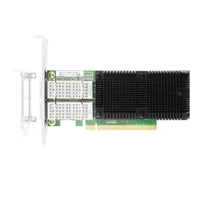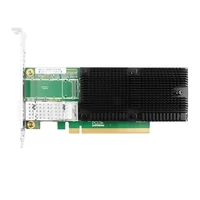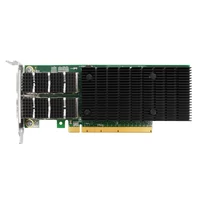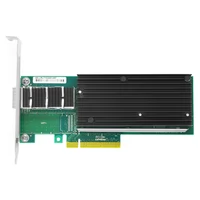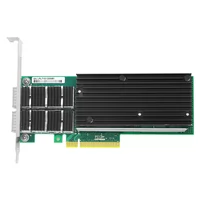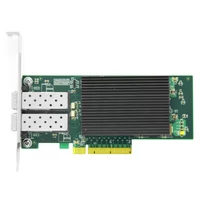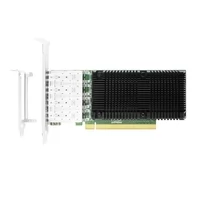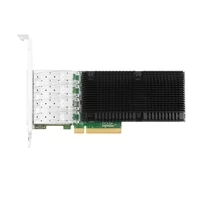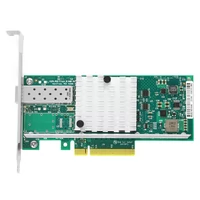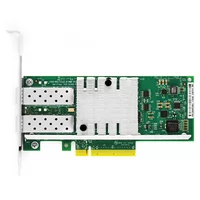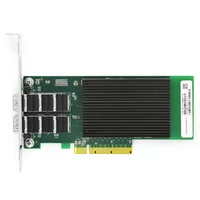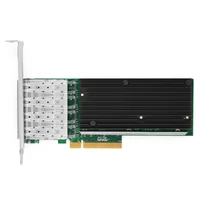The increasing digitalization in the world, currently done very fast, has increased the need for strong and effective network performance. As hard as it may be to facilitate and maintain normal operations, the Intel® Ethernet Converged Network Adapter X710-DA2 has emerged as an advanced design specific to these intricate requirements. This blog, in particular, wants to provide the reader insight into the functioning of the X710-DA2 and elaborate on its cutting-edge features, technical specifics, and position in the current-day IT environment. Having looked at its function in increasing network throughput, latency reduction, and data transfer security, it becomes evident that this particular adapter brings forth the mobility and flexibility of networks in their configuration. This article aspires to assist any interested reader, whether an IT enthusiast looking to renew your systems or an aficionado hunting ground for the recent technology in network solutions, in benefiting and understanding how the Intel® X710-DA2 functions, capabilities, and advantages are presented.
Table of Contents
ToggleWhat Makes the Intel® Ethernet Converged Network Adapter X710-DA2 Stand Out?

With multiple 10 Gb PCI-E weak point systems, Intel® Ethernet Converged Network Adapter X710-DA2 is a high-performance networking device. The subsystem supports multi-core scaling and constraint smearing for better performance harnessing, optimally improving productivity. The device features Data Center Bridging (DCB) and Storage over Ethernet, which promotes quick and accurate data traffic management. Moreover, its defaults include Network Virtualization offloads such as Virtual Extensible LAN (VXLAN) and Generic Network Virtualization Encapsulation (GENEVE), allowing deployability in virtualized interfaces. Such potential enhances the rate at which the X710-DA2 adapts to the ever-changing needs of networks without compromising optimal throughput and low latency.
Exploring the Adapter Design and Features
The Intel® Ethernet Converged Network Adapter X710-DA2 does not fall short of a vital structure that enables increased data transmission speed and improved network functionality. The adapter has two 10GbE connectors specialized for efficiently working the data centers. Thanks to the higher engineering of the X710-DA2, it comes with I/O offload technology that reduces a lot of CPU utilization and thus improves the capability of the systems to handle an increased load within a shorter period. Apart from this, Ethernet-supporting standards such as the IEEE 802.1Qav and 802.1Qbb facilitate effective traffic management, ensuring that high reliance on low-latency networks is possible. Furthermore, the added virtualization technologies and SR-IOV (Single Root I/O Virtualization) support highlight that advanced IP router solutions are easy to adopt.
Key Benefits for Data Center Applications
In addition to these, some significant benefits necessary for data center applications are provided by the Intel® Ethernet Converged Network Adapter X710-DA2. Primarily, this unit is equipped with dual 10GbE ports, giving high-speed data throughput, which facilitates a large volume of data processing tasks. I/O optimization in the adapter reduces CPU load to achieve productivity and efficiency. Vertical integration of Data Center Bridging with Ethernet DCB ensures accurate traffic management and lowers latency, making operations more reliable. Virtualization support, with the help of VXLAN and GENEVE, enhances network functions in virtualized environments, allowing growth and subsequent development. These features collectively make the Intel Ethernet Converged Network Adapter X710-DA2 an invaluable asset in today’s data centers, where connectivity, efficiency, and performance are paramount.
Understanding Port Partitioning and Virtualization
Port partitioning and virtualization are techniques that play a significant role in managing and improving networks from data centers. Port partitioning is the ability to carve a physical Network interface card (NIC) into several virtual ports, each acting autonomously. Port partitioning enables the allocation of resources – according to applications or workloads for their efficient use – in such a way as to reduce contention over bandwidth. Virtualization, including VXLAN and SR-IOV, allows the construction of logical networks over a physical shared network. This supports the movement of virtual private networks over the regular internet, thereby improving security and increasing capacity. These technologies combine to assist IT managers in the network’s flexible operational and resource management with better precision and better performance in the case of activity taking place in virtual space.
How to Ensure Compatibility with Other Systems?

Compatible Dell Systems and Servers
Ensure that the Lenovo X9T6T to be bought is compatible with Dell systems and servers. If it is mentioned that it is compatible with Dell systems, then the usual systems are from the PowerEdge server range, such as R740, R640, or T640. The provision of such servers facilitates networking features that support X710-DA2, resulting in suitable implementation of the device and its practicability. As a general rule, always check for compatibility with official Dell resources and documentation to ensure that the systems comply with the technical requirements and hardware specifications for intended deployment in a network.
OS Support and Integration
The Intel Ethernet Converged X710-DA2 is a network adapter operated under the support of practically all operating systems, making it easy for Ethernet LAN adapter users to deploy Windows OS. According to the leading websites in technology, it overcomes systems, including Microsoft Windows Server and several Linux distributions like Redhat Enterprise Linux, VMware ESXi, and Ubuntu server. The above tasks can be hassle-free and easily configured using Intel-supplied software and driver packages. To ensure that your pc and peripheral devices remain functional, it is advisable to regularly upgrade all drivers and firmware to the latest versions as directed by Intel and OS vendors. The system’s manuals and service websites accompanying the particular operating systems for validation and clarification of operation and integration issues concerning the existing background are critical.
Checking Firmware and Driver Requirements
To determine the firmware and driver requirements for the X710-DA2 network adapter, it is essential to rely on the latest information from leading technology portals. Kian and Sanchez persistently mention that applying the latest firmware and other drivers is one of the best practices for operating in a safe and modernized environment. In most cases, direct samples of the software packages required are peered on Systems Intel. Similarly, firmware and driver updating should also be included in the server maintenance activities schedule to eliminate any risks you may have. Several other places in which the updates will work effectively will not omit Collier Ultimate Business Synthesis Networks X7I209 E-Guru Support Network Regulation B. Bounding several methodologies about the convergence of these elements culminates in the optimal approach, hassle-free integration of the network adapter within the existing structure in place.
How Does the Intel X710 Enhance Network Performance?

Utilizing 10GBE Connectivity
The Intel X710 Network Adapter enhances the network’s operation by utilizing the 10 Gigabit Ethernet (10GbE), which is known to increase the speed of data transfers significantly. The x710 features 10GbE connections and is presented to the audience via websites such as Intel’s support, Tom’s Hardware, and Anan Tech since it releases high data transfer rates consequential for data applications and contemporary data halls. Such connections help lower delays and increase capacity, facilitating the movement and processing of large amounts of data and many channels. The adapter strategically combines cutting-edge off-loading capabilities and intelligent acceleration technologies, as these resources point out, which focus on how well the CPU works, hence the effectiveness of the network. Such versatility is essential in supporting high-performance areas through high-performing and flexible networking strategies, which are important in cloud and virtualization computing and complex enterprise environments.
Role of PCIE 3.0 and PCIE Ethernet Interfaces
The introduction of PCIe 3.0 assists in enhancing the network quality owing to enhanced data throughput compared to older versions; as per the findings of TechRadar, PCWorld, CNET, and other related technology sources, one such impressive feature of PCIe 3 is the high bandwidth that facilitates the transmission of more data quickly from the network adapter to the system components. This reduces data traffic and improves the system’s performance. This effectiveness is further strengthened by PCIe Ethernet interfaces, which provide fast data transfer and processing while offering low-inhibition communication. This is necessary to keep up with the high demands of operating conditions such as virtualized data centers and high-performance computing clusters. Therefore, PCIe 3.0 and PCIe Ethernet interfaces are complementary in that they advocate for sophisticated systems and embrace mounting information processing, supporting modern business networks and meeting their requirements.
Enabling Network Virtualization in Modern Infrastructures
Modern network infrastructures use two technologies, namely, software-defined networking (SDN) and network functions virtualization (NFV), to realize network virtualization. It is noted from several technology websites like Cisco, VMware, and Juniper Networks that SDN separates the network infrastructure control, which makes it possible to manage and automate network elements from a centralized point. The result is that resources can be quickly and easily redistributed, which increases the system’s flexibility and decreases its operational costs. With NFV, these functions are realized since network functions such as firewalls and load balancers are turned into virtual access and executed on conventional servers. The convergence of SDN and NFV fulfills this, as today’s needs for both enterprise bandwidth and security level are ever on the rise, and this calls for an architecture that efficiently supports the growth.
What are the uses of Ethernet-converged network adapters in modern enterprises?

Importance in Server Adapter Solutions
Regarding server adapter solutions, ethernet converged network adapters uphold the most notable position thanks to their functionality in combining several network elements in one device. Searching Google for relevant materials, especially for companies such as Cisco and Dell Technologies, demonstrates that such adapters make the work quicker, have less time to respond, and better manage the network. Such a conversion decreases the overall server infrastructure and increases the efficiency and scalability of the solution. In addition, the ethernet-converged network adapters are compatible with technologies such as RDMA, which increase the data’s access speed and decrease the CPU’s load. They help businesses cope with the ever-growing amount of data traffic without incurring high operational costs, thus keeping up with the progress of the modern IT world.
Leveraging Intel Ethernet Converged Capabilities
Intel’s Ethernet-converged network adapters are formidable tools to increase the flexibility and productivity of today’s data centers. Current notions advanced by market leaders like Intel and TechRadar put forward that these adapters have the capabilities for unified networking and virtualization, which enhances the efficiency of data centers. The adapters from Intel support the indirect method of accessing memory over a network with the help of remote direct access, which improves both the latency and the CPU resource load, thus compelling performance in the data network. In addition, with network virtualization support and flexible port partitioning features, Intel’s solutions allow easy connection to current infrastructure and efficiently control data traffic within an organization while reducing capital and operational costs. These capacities place Intel’s Ethernet-converged network adapters at the core of the solutions designed to meet the increasing challenge of speed, accessibility, and performance in modern-day IT environments.
Where to Find the Latest Drivers and Technical Support?

Accessing Product Support Resources
It is best to go to the supporting institution’s website to obtain updated drivers and process any technical issues regarding the Ethernet-converged adapters from Intel. Driver downloads, technical documents, and software updates are among the website’s valuable resources. Also, any technical problems can be resolved more effectively by contacting Intel’s dedicated support team through online contact forms or community forums. Sometimes, it is necessary to follow specialized sites that write about technologies and review them, such as TechRadar or CNET, about new progress and ways of assistance with the progress of Intel hardware.
Downloading Latest Drivers and Updates
First, to download the most recent drivers and updates on Intel’s Ethernet-converged network adapters, one should go to the Intel® Download Centre at downloadcentral.intel.com. Users can look for a specific product from this official site and download the latest drivers that fit the individual’s hardware. There are also informative sites, such as Tom’s Hardware and PCMag, with helpful articles and reviews that provide email about driver updates to their subscribers. These resources ensure you get the most updated information and software improvements from Intel and other reliable technology sources.
Utilizing NIC Card Documentation and Guides
To get the best out of the documentation and guides provided for NIC (Network Interface Card) cards, visit the best sites currently available. A case in point is Intel’s official support web page, which has a lot of relevant and competitively presented technical information about the NIC products. In addition, TechRadar provides professional reviews and installation instructions, which help set this equipment up and deal with some problems. However, pcMag also contains some articles and guides devoted to the issues of performance bottlenecks and upgrades with the use of an Intel Ethernet Converged X710-DA2 network adapter. Thanks to these top three sites, the user can fully comprehend the functioning of NIC cards and ensure that the devices are optimally set up.
Reference Sources
Frequently Asked Questions (FAQs)
Q: What is the Intel® Ethernet Converged Network Adapter X710-DA2 meant for?
A: Network adapters have undergone many improvements, the latest being the Intel® Ethernet Converged Network Adapter X710-DA2. Unlike traditional full-height PCIe low-profile adapters, it is a dual-port network interface card that supports advanced technology in data centers and enterprise applications to span versatile network structures utilizing SFP+ ports.
Q: What are the key features of the X710-DA2 ethernet network adapter?
A: The Intel Ethernet Converged Network Adapter X710-DA2 comes with two 10Gb ports, a PCIe x8 3.0 interface, advanced features such as virtualization, Intel® Ethernet Flow Director, which helps in load balancing applications, and more. It can also provide low-latency, energy-efficient performance and use several offload features to lessen CPU load.
Q: Would one be able to use the Intel X710-DA2 with randomly available software operating systems?
A: As earlier noted, the Intel X710-DA2 network card’s compatibility makes it usable with diverse operating systems such as Linux, Windows Server, VMware ESXi, and others. This kind of usage allows deployment across various enterprise and data center situations.
Q: What type of connections does the X710-DA2 use?
A: The X710-DA2 employs SFP+ connectorized connections. They enable the connection of fiber optic and RJ45 copper cables, allowing users to select suitable transceivers or direct-attach wires depending on the needs of the network infrastructure.
Q: How does the X710-DA2 relate to other Intel Ethernet adapters, such as the 82599EN controller?
A: Although both belong to the Intel Ethernet compartment, the X710DA2 is much more recent in technology than the 82599EN controller. Aside from the higher-speed interface, the X710-DA2 has a lower power requirement and accommodates other technologies used in DPDK to enable high-end packet processing.
Q: Can Intel X710-DA2 be used on low-profile servers?
A: Yes, the Intel X710-DA2 has a low profile and a standard design, giving it broad applicability across different server configurations, even low-profile servers with limited space.
Q: What does having an X710-DA2 10 Gigabit ethernet network adapter bring to the users?
A: A 10 Gigabit ethernet adapter like the X710-DA2 provides plenty of bandwidth and is more effective than Giga Ethernet. As a result, the data transfer rate and network efficiency are enhanced. This greatly helps in data-oriented tasks, virtualized environments, and high-performance computing.
Q: What is the level of the X710-DA2 variable in terms of virtualization networking capabilities?
A: The X710-DA2 includes advanced virtualization support such as SR-IOV (Single Root I/O Virtualization) and VMDq (Virtual Machine Device Queues). These technologies increase network efficiency in virtual environments by enabling network resources to be directly allocated to VMs and sorting out packets efficiently.
Related Products:
-
 Intel® E810-CQDA2 100G Ethernet Network Adapter PCIe v4.0 x16 Dual port QSFP28
$589.00
Intel® E810-CQDA2 100G Ethernet Network Adapter PCIe v4.0 x16 Dual port QSFP28
$589.00
-
 Intel® E810-CQDA1 100G Ethernet Network Adapter PCIe v4.0 x16 Single port QSFP28
$409.00
Intel® E810-CQDA1 100G Ethernet Network Adapter PCIe v4.0 x16 Single port QSFP28
$409.00
-
 Intel®Ethernet Controller E810-CAM2 100G Dual-Port QSFP28, Ethernet Network Adapter PCIe 4.0 x16
$609.00
Intel®Ethernet Controller E810-CAM2 100G Dual-Port QSFP28, Ethernet Network Adapter PCIe 4.0 x16
$609.00
-
 Intel® XL710-BM1 QDA1 Single Port 40 Gigabit QSFP+ PCI Express x8 Ethernet Network Interface Card PCIe v3.0
$309.00
Intel® XL710-BM1 QDA1 Single Port 40 Gigabit QSFP+ PCI Express x8 Ethernet Network Interface Card PCIe v3.0
$309.00
-
 Intel® XL710 QDA2 Dual Port 40 Gigabit QSFP+ PCI Express x8 Ethernet Network Interface Card PCIe v3.0
$359.00
Intel® XL710 QDA2 Dual Port 40 Gigabit QSFP+ PCI Express x8 Ethernet Network Interface Card PCIe v3.0
$359.00
-
 Intel® XXV710 DA2 Dual Port 25 Gigabit SFP28 PCI Express x8 Ethernet Network Interface Card PCIe v3.0
$269.00
Intel® XXV710 DA2 Dual Port 25 Gigabit SFP28 PCI Express x8 Ethernet Network Interface Card PCIe v3.0
$269.00
-
 Intel® E810-XXVDA4 25G Ethernet Network Adapter PCI Express v4.0 x16 Quad-port SFP28
$495.00
Intel® E810-XXVDA4 25G Ethernet Network Adapter PCI Express v4.0 x16 Quad-port SFP28
$495.00
-
 Intel® E810-CAM1 Controller PCI Express v4.0 X8 25G Quad-port Ethernet Server Adapter
$495.00
Intel® E810-CAM1 Controller PCI Express v4.0 X8 25G Quad-port Ethernet Server Adapter
$495.00
-
 Intel® 82599EN SR1 Single Port 10 Gigabit SFP+ PCI Express x8 Ethernet Network Interface Card PCIe v2.0
$115.00
Intel® 82599EN SR1 Single Port 10 Gigabit SFP+ PCI Express x8 Ethernet Network Interface Card PCIe v2.0
$115.00
-
 Intel® 82599ES SR2 Dual Port 10 Gigabit SFP+ PCI Express x8 Ethernet Network Interface Card PCIe v2.0
$159.00
Intel® 82599ES SR2 Dual Port 10 Gigabit SFP+ PCI Express x8 Ethernet Network Interface Card PCIe v2.0
$159.00
-
 Intel® X710-BM2 DA2 Dual Port 10 Gigabit SFP+ PCI Express x8 Ethernet Network Interface Card PCIe v3.0
$179.00
Intel® X710-BM2 DA2 Dual Port 10 Gigabit SFP+ PCI Express x8 Ethernet Network Interface Card PCIe v3.0
$179.00
-
 Intel® XL710-BM1 DA4 Quad Port 10 Gigabit SFP+ PCI Express x8 Ethernet Network Interface Card PCIe v3.0
$309.00
Intel® XL710-BM1 DA4 Quad Port 10 Gigabit SFP+ PCI Express x8 Ethernet Network Interface Card PCIe v3.0
$309.00

